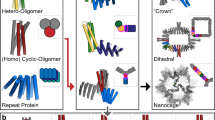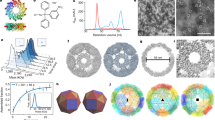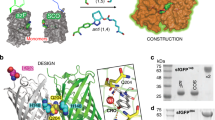Abstract
Symmetrical protein oligomers are ubiquitous in biological systems and perform key structural and regulatory functions. However, there are few methods for constructing such oligomers. Here we have engineered completely synthetic, symmetrical oligomers by combining pairs of oppositely supercharged variants of a normally monomeric model protein through a strategy we term ‘supercharged protein assembly’ (SuPrA). We show that supercharged variants of green fluorescent protein can assemble into a variety of architectures including a well-defined symmetrical 16-mer structure that we solved using cryo-electron microscopy at 3.47 Å resolution. The 16-mer is composed of two stacked rings of octamers, in which the octamers contain supercharged proteins of alternating charges, and interactions within and between the rings are mediated by a variety of specific electrostatic contacts. The ready assembly of this structure suggests that combining oppositely supercharged pairs of protein variants may provide broad opportunities for generating novel architectures via otherwise unprogrammed interactions.
This is a preview of subscription content, access via your institution
Access options
Access Nature and 54 other Nature Portfolio journals
Get Nature+, our best-value online-access subscription
$29.99 / 30 days
cancel any time
Subscribe to this journal
Receive 12 print issues and online access
$259.00 per year
only $21.58 per issue
Buy this article
- Purchase on Springer Link
- Instant access to full article PDF
Prices may be subject to local taxes which are calculated during checkout






Similar content being viewed by others
Code availability
Source code for HOOMD-blue is available at http://glotzerlab.engin.umich.edu/hoomd-blue/ and at https://bitbucket.org/glotzer/hoomd-blue/. Specific source codes are available upon request.
Data availability
The data generated and analysed in this study, including sequence verification files and the data associated with all figures, are available from the corresponding authors upon reasonable request. The cryo-EM density map of the Ceru+32/GFP−17 protomer has been deposited in the EMDB under accession code EMD-9104. The corresponding atomic model has been deposited in the PDB under accession code 6MDR.
References
Whitesides, G. M. & Grzybowski, B. Self-assembly at all scales. Science 295, 2418–2421 (2002).
Blundell, T. L. & Srinivasan, N. Symmetry, stability, and dynamics of multidomain and multicomponent protein systems. Proc. Natl Acad. Sci. USA 93, 14243–14248 (1996).
Levy, E. D., Boeri Erba, E., Robinson, C. V. & Teichmann, S. A. Assembly reflects evolution of protein complexes. Nature 453, 1262–1265 (2008).
Goodsell, D. S. & Olson, A. J. Structural symmetry and protein function. Annu. Rev. Biophys. Biomol. Struct. 29, 105–153 (2000).
André, I., Strauss, C. E., Kaplan, D. B., Bradley, P. & Baker, D. Emergence of symmetry in homooligomeric biological assemblies. Proc. Natl Acad. Sci. USA 105, 16148–16152 (2008).
Plaxco, K. W. & Gross, M. Protein complexes: the evolution of symmetry. Curr. Biol. 19, R25–R26 (2009).
Bergendahl, L. T. & Marsh, J. H. Functional determinants of protein assembly into homomeric complexes. Sci. Rep. 7, 4932 (2017).
Padilla, J. E., Colovos, C. & Yeates, T. O. Nanohedra: using symmetry to design self assembling protein cages, layers, crystals and filaments. Proc. Natl Acad. Sci. USA 98, 2217–2221 (2001).
Lai, Y.-T., Cascio, D. & Yeates, T. O. Structure of a 16-nm cage designed by using protein oligomers. Science 336, 1129 (2012).
Alberstein, R., Suzuki, Y., Paesani, F. & Tezcan, F. A. Engineering the entropy-driven free-energy landscape of a dynamic nanoporous protein assembly. Nat. Chem. 10, 732–739 (2018).
Badieyan, S. et al. Symmetry‐directed self‐assembly of a tetrahedral protein cage mediated by de novo‐designed coiled coils. Chembiochem 18, 1888–1892 (2017).
Brodin, J. D., Carr, J. R., Sontz, P. A. & Tezcan, F. A. Exceptionally stable, redox-active supramolecular protein assemblies with emergent properties. Proc. Natl Acad. Sci. USA 111, 2897–2902 (2014).
Yeates, T. O. Geometric principles for designing highly symmetric self-assembling protein nanomaterials. Annu. Rev. Biophys. 46, 23–42 (2017).
Boyken, S. E. et al. De novo design of protein homo-oligomers with modular hydrogen-bond network-mediated specificity. Science 352, 680–687 (2016).
Bale, J. B. et al. Accurate design of megadalton-scale two-component icosahedral protein complexes. Science 353, 389–394 (2016).
Hsia, Y. et al. Design of a hyperstable 60-subunit protein dodecahedron. Nature 535, 136–139 (2016).
Butterfield, G. L. et al. Evolution of a designed protein assembly encapsulating its own RNA genome. Nature 552, 415–420 (2017).
Kobayashi, N. & Arai, R. Design and construction of self-assembling supramolecular protein complexes using artificial and fusion proteins as nanoscale building blocks. Curr. Opin. Biotechnol. 46, 57–65 (2017).
Damasceno, P. F., Engel, M. & Glotzer, S. C. Predictive self-assembly of polyhedra into complex structures. Science 337, 453–457 (2012).
Paik, T. & Murray, C. B. Shape-directed binary assembly of anisotropic nanoplates: a nanocrystal puzzle with shape-complementary building blocks. Nano Lett. 13, 2952–2956 (2013).
Gong, J. et al. Shape-dependent ordering of gold nanocrystals into large-scale superlattices. Nat. Commun. 8, 14038 (2017).
Wolters, J. R. et al. Self-assembly of ‘Mickey Mouse’ shaped colloids into tube-like structures: experiments and simulations. Soft Matter 11, 1067–1077 (2015).
Boles, M. A., Engel, M. & Talapin, D. V. Self-assembly of colloidal nanocrystals: from intricate structures to functional materials. Chem. Rev. 116, 11220–11289 (2016).
Fu, L. et al. Assembly of hard spheres in a cylinder: a computational and experimental study. Soft Matter 13, 3296–3306 (2017).
Ye, X. et al. Competition of shape and interaction patchiness for self-assembling nanoplates. Nat. Chem. 5, 466–473 (2013).
Zhang, Z. & Glotzer, S. C. Self-assembly of patchy particles. Nano Lett. 4, 1407–1413 (2004).
Giacometti, A., Lado, F., Largo, J., Pastore, G. & Sciortino, F. Effects of patch size and number within a simple model of patchy colloids. J. Chem. Phys. 132, 174110 (2010).
Pawar, A. B. & Kretzschmar, I. Fabrication, assembly and application of patchy particles. Macromol. Rapid Commun. 31, 150–168 (2010).
Gong, Z., Hueckel, T., Yi, G. R. & Sacanna, S. Patchy particles made by colloidal fusion. Nature 550, 234–238 (2017).
Duguet, E., Hubert, C., Chomette, C., Perroc, A. & Ravaine, S. Patchy colloidal particles for programmed self-assembly. C. R. Chimi 19, 173–182 (2016).
Woo, S. & Rothemund, P. W. Programmable molecular recognition based on the geometry of DNA nanostructures. Nat. Chem. 3, 620–627 (2011).
Gerling, T., Wagenbauer, K. F., Neunerm, A. M. & Dietz, H. Dynamic DNA devices and assemblies formed by shape-complementary, non-base pairing 3D components. Science 347, 1446–1452 (2015).
Sheinerman, F. B., Norel, R. & Honig, B. Electrostatic aspects of protein–protein interactions. Curr. Opin. Struct. Biol. 10, 153–159 (2000).
Liljeström, V., Mikkilä, J. & Kostiainen, M. A. Self-assembly and modular functionalization of three-dimensional crystals from oppositely charged proteins. Nat. Commun. 5, 4445 (2014).
Kostiainen, M. A. et al. Electrostatic assembly of binary nanoparticle superlattices using protein cages. Nat. Nanotech. 8, 52–56 (2012).
Seebeck, F. P., Woycechowsky, K. J., Zhuang, W., Rabe, J. P. & Hilvert, D. A simple tagging system for protein encapsulation. J. Am. Chem. Soc. 128, 4516–4517 (2006).
Wörsdörfer, B., Woycechowsky, K. J. & Hilvert, D. Directed evolution of a protein container. Science 331, 589–592 (2011).
Held, M. et al. Engineering formation of multiple recombinant Eut protein nanocompartments in E. coli. Sci. Rep. 6, 24359 (2016).
Beck, T., Tetter, S., Künzle, M. & Hilvert, D. Construction of Matryoshka-type structures from supercharged protein nanocages. Angew. Chem. Int. Ed. 54, 937–940 (2014).
Sun, H., Luo, Q., Hou, C. & Liu, J. Nanostructures based on protein self-assembly: from hierarchical construction to bioinspired materials. Nanotoday 14, 16–41 (2017).
Lawrence, M. S., Phillips, K. J. & Liu, D. R. Supercharging proteins can impart unusual resilience. J. Am. Chem. Soc. 129, 10110–10112 (2007).
Der, B. S. et al. Alternative computational protocols for supercharging protein surfaces for reversible unfolding and retention of stability. PLoS One 31, e64363 (2013).
Oh, H. J., Gather, M. C., Song, J.-J. & Yun, S. H. Lasing from fluorescent protein crystals. Opt. Express 22, 31411–31416 (2014).
Ormö, M. et al. Crystal structure of the Aequorea victoria green fluorescent protein. Science 273, 1392–1395 (1996).
Bolhuis, P. & Frenkel, D. Tracing the phase boundaries of hard spherocylinders. J. Chem. Phys. 106, 666–687 (1997).
Rizzo, M. A., Springer, G. H., Granada, B. & Piston, D. W. An improved cyan fluorescent protein variant useful for FRET. Nat. Biotechnol. 4, 445–449 (2004).
Goedhart, J. et al. Bright cyan fluorescent protein variants identified by fluorescence lifetime screening. Nat. Methods 7, 137–139 (2010).
Goedhart, J. et al. Structure-guided evolution of cyan fluorescent proteins towards a quantum yield of 93%. Nat. Commun. 3, 751 (2012).
García-Seisdedos, H., Empereur-Mot, C., Elad, N. & Levy, E. D. Proteins evolve on the edge of supramolecular self-assembly. Nature 548, 244–247 (2017).
Hassan, P. A., Rana, S. & Verma, G. Making sense of Brownian motion: colloid characterization by dynamic light scattering. Langmuir 31, 3–12 (2015).
Bajar, B. T., Wang, E. S., Zhang, S., Lin, M. Z. & Chu, J. A guide to fluorescent protein FRET pairs. Sensors 16, E1488 (2016).
Anderson, J. A., Lorenz, C. D. & Travesset, A. General purpose molecular dynamics simulations fully implemented on graphics processing units. J. Comp. Phys. 227, 5342–5359 (2008).
Glaser, J. et al. Strong scaling of general-purpose molecular dynamics simulations on GPUs. Comp. Phys. Commun. 192, 97–107 (2015).
Sinkovits, D. W., Barr, S. A. & Luijten, E. Rejection-free Monte Carlo scheme for anisotropic particles. J. Chem. Phys. 136, 144111 (2012).
Krissinel, E. & Henrick, K. Inference of macromolecular assemblies from crystalline state. J. Mol. Biol. 372, 774–797 (2007).
Pédelacq, J. D., Cabantous, S., Tran, T., Terwilliger, T. C. & Waldo, G. S. Engineering and characterization of a superfolder green fluorescent protein. Nat. Biotechnol. 24, 79–88 (2006).
Yang, F., Moss, L. G. & Phillips, G. B. Jr. The molecular structure of green fluorescent protein. Nat. Biotechnol. 14, 1246–1251 (1996).
Lin, M. Y. et al. Universal diffusion-limited colloid aggregation. J. Phys. Condens. Matter 2, 3039–3113 (1990).
Miklos, A. E. et al. Structure-based design of supercharged, highly thermoresistant antibodies. Chem. Biol. 19, 449–455 (2012).
Johnson, L. B., Park, S., Gintner, L. P. & Snow, C. D. Characterization of supercharged cellulase activity and stability in ionic liquids. J. Mol. Catal. B 132, 84–90 (2016).
Zuris, J. A. et al. Cationic lipid-mediated delivery of proteins enables efficient protein-based genome editing in vitro and in vivo. Nat. Biotechnol. 33, 73–80 (2015).
Acknowledgements
This material is based on work supported by the US Army Research Laboratory and the US Army Research Office under grant no. W911NF-1–51–0120 to the University of Texas at Austin and under grant no. W911NF-15–1–0185 to the University of Michigan. Computational resources and services for simulation work were supported by Advanced Research Computing at the University of Michigan, Ann Arbor. This work used the Extreme Science and Engineering Discovery Environment (XSEDE), which is supported by National Science Foundation grant no. ACI-1053575 (XSEDE award DMR 140129). A.J.S. is supported by an Arnold O. Beckman Postdoctoral Fellowship. D.W.T. is a CPRIT Scholar supported by the Cancer Prevention and Research Institute of Texas (RR160088). This work was supported in part by a Welch Foundation grant F-1938 (to D.W.T.). The authors thank N. Wang for help with building the atomic model, B. Dear for helpful discussions regarding interpretation of DLS data, Texas Materials Institute, part of the Material Science Engineering programme at University Texas at Austin, for supporting the management of the DLS, A. Miklos for helpful discussions regarding supercharged proteins and A. Webb for assistance with confocal microscopy, and the Center for Biomedical Research Support Microscopy and Imaging Facility at the University Texas at Austin for supporting the management of the confocal microscope.
Author information
Authors and Affiliations
Contributions
A.J.S., Y.Z., V.R., J.Gl., J.Go., A.P., C.J., D.W.T., S.C.G. and A.D.E. conceived and designed the experiments. A.P., A.J.S. and J.Go. designed proteins. A.J.S., B.R.M. and A.P. expressed the proteins. A.P., J.Go. and C.J. performed early optimization of DLS and FRET experiments. A.J.S. and B.R.M. carried out DLS and FRET experiments and analysed the data. J.C.G., J.C.L. and D.W.T. performed the negative stain EM experiments and analysed the data. Y.Z. performed the cryo-EM experiments and atomic model building. A.J.S., Y.Z. and D.W.T. interpreted the cryo-electron microscopy structure and produced the structure figures. V.R. and J.Gl. designed the simulations. V.R. performed simulations. A.J.S. and J.Go. performed and interpreted the confocal microscopy experiments. A.J.S., Y.Z., V.R., J.Gl., S.C.G., D.W.T. and A.D.E. wrote the manuscript, and all authors reviewed and commented on the manuscript.
Corresponding authors
Ethics declarations
Competing interests
The authors declare no competing interests.
Additional information
Publisher’s note: Springer Nature remains neutral with regard to jurisdictional claims in published maps and institutional affiliations.
Supplementary information
Supplementary Information
Supplementary Methods, Supplementary Materials and Supplementary Figures
Rights and permissions
About this article
Cite this article
Simon, A.J., Zhou, Y., Ramasubramani, V. et al. Supercharging enables organized assembly of synthetic biomolecules. Nature Chem 11, 204–212 (2019). https://doi.org/10.1038/s41557-018-0196-3
Received:
Accepted:
Published:
Issue Date:
DOI: https://doi.org/10.1038/s41557-018-0196-3
This article is cited by
-
Convoluted micellar morphological transitions driven by tailorable mesogenic ordering effect from discotic mesogen-containing block copolymer
Nature Communications (2024)
-
Shifting computational boundaries for complex organic materials
Nature Physics (2021)
-
Asymmetrizing an icosahedral virus capsid by hierarchical assembly of subunits with designed asymmetry
Nature Communications (2021)
-
Programmed spatial organization of biomacromolecules into discrete, coacervate-based protocells
Nature Communications (2020)
-
Assembly of a patchy protein into variable 2D lattices via tunable multiscale interactions
Nature Communications (2020)



